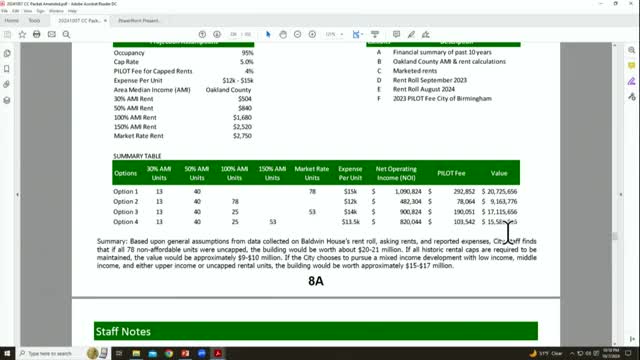Community center plans spark debate over shared spaces
October 07, 2024 | Birmingham City, Oakland County, Michigan
This article was created by AI summarizing key points discussed. AI makes mistakes, so for full details and context, please refer to the video of the full meeting. Please report any errors so we can fix them. Report an error »

In a recent government meeting, officials discussed the ongoing development of a community center that aims to integrate services for various age groups, including seniors and youth. The meeting highlighted the need for a comprehensive design that accommodates the programming needs of both the NEXT organization and the YMCA, while also addressing financial constraints.
The commission reviewed two proposed options for the center's design, with the first being a 53,300 square foot facility that includes space for both organizations, and the second a smaller 36,000 to 40,000 square foot building dedicated solely to NEXT. However, after extensive discussions, it became clear that neither option met the commission's expectations, prompting a request for further exploration of alternatives.
City officials emphasized the importance of shared spaces within the building to maximize utility and minimize costs. They noted that the programming analysis indicated that a facility between 44,500 and 53,000 square feet could adequately serve the needs of both organizations while allowing for future growth. The analysis included detailed evaluations of room utilization and peak usage times, revealing potential overlaps in programming that could be efficiently managed.
Concerns were raised about the proposed size of the building, with some commissioners advocating for a more streamlined approach based on benchmarking data from similar facilities in other communities. They argued that the current proposals appeared to be excessive compared to the needs of Birmingham's population and the services offered by both organizations.
The discussion also touched on the importance of community integration, with some members advocating for a single entrance to foster a welcoming environment for all users, rather than separate entrances for different groups. This sentiment aligns with the overarching goal of creating a community center that serves as a hub for diverse activities and interactions.
As the meeting concluded, the commission agreed to continue discussions and refine the proposals, with a follow-up public hearing scheduled for October 28. The focus will remain on ensuring that the final design is both functional and financially responsible, ultimately aiming to create a space that meets the evolving needs of the Birmingham community.
The commission reviewed two proposed options for the center's design, with the first being a 53,300 square foot facility that includes space for both organizations, and the second a smaller 36,000 to 40,000 square foot building dedicated solely to NEXT. However, after extensive discussions, it became clear that neither option met the commission's expectations, prompting a request for further exploration of alternatives.
City officials emphasized the importance of shared spaces within the building to maximize utility and minimize costs. They noted that the programming analysis indicated that a facility between 44,500 and 53,000 square feet could adequately serve the needs of both organizations while allowing for future growth. The analysis included detailed evaluations of room utilization and peak usage times, revealing potential overlaps in programming that could be efficiently managed.
Concerns were raised about the proposed size of the building, with some commissioners advocating for a more streamlined approach based on benchmarking data from similar facilities in other communities. They argued that the current proposals appeared to be excessive compared to the needs of Birmingham's population and the services offered by both organizations.
The discussion also touched on the importance of community integration, with some members advocating for a single entrance to foster a welcoming environment for all users, rather than separate entrances for different groups. This sentiment aligns with the overarching goal of creating a community center that serves as a hub for diverse activities and interactions.
As the meeting concluded, the commission agreed to continue discussions and refine the proposals, with a follow-up public hearing scheduled for October 28. The focus will remain on ensuring that the final design is both functional and financially responsible, ultimately aiming to create a space that meets the evolving needs of the Birmingham community.
View full meeting
This article is based on a recent meeting—watch the full video and explore the complete transcript for deeper insights into the discussion.
View full meeting
